|
|
|
Sort Order |
|
|
|
Items / Page
|
|
|
|
|
|
|
| Srl | Item |
| 1 |
ID:
120236


|
|
|
|
|
| Publication |
2013.
|
| Summary/Abstract |
Cambodia has struggled to diversify its economy in the past decade despite nearly double-digit growth per annum. Chinese interest and investment during this time comes at a critical juncture. This investment is driven from Taiwan and Hong Kong and has spilled into multiple industries, but most notably the garment industry which represents 14 per cent of Cambodia's
GDP and is by far its largest foreign exchange earner. The specific investment in garments demonstrates hand-in-hand governance, where governments and firms work together to create an environment generating growth, and thus far has produced positive results. Surprisingly, Cambodia has been able to achieve significant growth with foreign investment despite the minimal enforcement of policies. The garment industry is an exception to the rule and may have enjoyed good enough governance to succeed.
|
|
|
|
|
|
|
|
|
|
|
|
|
|
|
|
| 2 |
ID:
182943
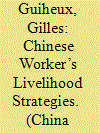

|
|
|
|
|
| Summary/Abstract |
This article evaluates the possibilities of individual agency in the case of a group of workers employed by a large garment factory in Zhejiang Province. The issue of workers’ ability to exercise power is tested by two sets of facts: workers’ job histories and workers’ household expenses. The author argues that workers’ agency is largely dependent upon gender, age, place of origin, and living arrangements. Workers’ main power is the possibility to quit a job. The overall conclusion is that agency remains limited by the precariousness of workers’ lives from a lifelong perspective.
|
|
|
|
|
|
|
|
|
|
|
|
|
|
|
|
| 3 |
ID:
170979
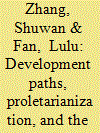

|
|
|
|
|
| Summary/Abstract |
From the perspective of development, this article examines the power relations among local states, capital, and migrant laborers that shape the making of proletarians/semi-proletarians in two famous garment manufacturing areas, Humen in the Pearl River Delta and Pinghu in the Yangtze River Delta. It emphasizes the distinct forms of association in the daily production process of workers against the exploitation by capital and the control of states embedded in two different power relations. In Humen, a high proportion of external investment in the garment industry and lack of local authority regulatory resources, accompanied by highly mobile migrant workers without local hukous, undermines the foundation of daily association in production. Migrant workers generally work with subcontractors and "vote with their feet." In Pinghu, the historical heritage of collective economies enhances the control of local authorities over both labor and capital, which has led to the full proletarianization of garment industry workers. Meanwhile, embedding deeply in local communities empowers local workers to associate in cooperative production teams and negotiate with capitalists collectively, resulting in a relatively higher payback. Both forms of imperceptible daily struggles generate transformation of labor institutions in the two areas.
|
|
|
|
|
|
|
|
|
|
|
|
|
|
|
|
| 4 |
ID:
178759


|
|
|
|
|
| Summary/Abstract |
This essay examines two films by the Chinese documentary filmmaker Wang Bing about temporary migrant workers in small, privately owned garment workshops in Zhejiang Province, China: Bitter Money (Ku Qian; 2016) and 15 Hours (Shi Wu Xiao Shi; 2017). Wang’s films portray Chinese garment workers’ lived experiences of “suspension,” as defined by Biao Xiang in this issue, in unique cinematic ways. Social sciences have paid close attention to the experiences of migrant workers, but art documentaries use audiovisual and aesthetic means to explore their everyday reality, producing what D. MacDougall calls distinctive “affective knowledge.” Wang’s films are usually categorized as part of the Sixth Generation of Chinese filmmakers, known for capturing social issues through observational methods. In this essay, I identify Wang’s works with the aesthetics of “slow cinema” and a global documentary trend in the visual arts as theorized by T. J. Demos in The Migrant Image. Based on close observation coupled with empathetic insight, Wang develops his own subjective method to portray people in a transformed and still changing China, where suspension is a common state of being. Ultimately, Wang’s films not only make the personal experiences of migrant workers visible and tangible, but also problematize their underlying, collective condition of suspension due to the contract labour system and associated hypermobility. The suspension approach suggests a productive way of bringing documentary art and social sciences into dialogue.
|
|
|
|
|
|
|
|
|
|
|
|
|
|
|
|
| 5 |
ID:
141077
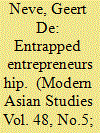

|
|
|
|
|
| Summary/Abstract |
As neoliberal restructuring leads to the rise of labour market intermediaries globally, labour contractors are being vilified as unscrupulous recruiters and as wicked figures who exploit and harass. Based on long-term ethnographic research among workers and contractors in the Tamil Nadu garment industry, this article argues for a more careful and grounded analysis of labour contractors’ role and position under neoliberalization. Evidence is presented of contractors’ precarious position at the tail end of global production networks and three conclusions are drawn. First, contractors reveal themselves to be a remarkably unrecognized source of entrepreneurship, flexibility, and skills acquisition, which facilitates manufacturers’ participation in global markets. Second, despite their resourcefulness and resilience, contractors find themselves trapped between management and the workforce, and in an overall situation of vulnerability as a result of the informal nature of their activities and the vagaries of the neoliberal market. For many of them this results in a highly fluid and unstable class experience, in which they struggle to materialize aspirations for upward mobility. Finally, neoliberal conditions tend to undermine rather than enhance contractors’ entrepreneurial success and to weaken rather than intensify their power with regard to both capital and labour.
|
|
|
|
|
|
|
|
|
|
|
|
|
|
|
|
| 6 |
ID:
181888
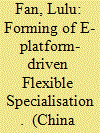

|
|
|
|
|
| Summary/Abstract |
E-commerce platforms have promoted the rise of consumer-demand-driven supply chains in the garment industry. This kind of supply chain has raised the demand for a new type of production organisation exemplified by low processing costs, small batches, multi-varieties, and quick reorders. Drawing on the insights of flexible specialisation theory, this paper proposes the concept of e-platform-driven flexible specialisation to describe this emerging production organisation form. This flexible specialisation is characterised by highly fragmented and informal production organisations such as husband-and-wife-run workshops and production units based on daily wage workers. In the context of a severe labour shortage in the garment industry, workers participate in the construction of these informal production organisations in order to obtain higher wages and work autonomy. However, the increase in informal employment also makes garment workers more atomised and vulnerable to social risks such as the outbreak of COVID-19. It is necessary to innovate labour relation negotiation modes to cope with the impacts of the rise of the platform economy on labour relations.
|
|
|
|
|
|
|
|
|
|
|
|
|
|
|
|
| 7 |
ID:
105228


|
|
|
|
|
| Publication |
2011.
|
| Summary/Abstract |
This article examines the capabilities of Cambodia's garment industry in the post-safeguard policy era, and its future prospects. It first analyzes the industry's experience pre-2005, then discusses the role of foreign investors and the government's open-economy policy. The paper then looks at post-2005 industry problems and offers some recommendations for future growth.
|
|
|
|
|
|
|
|
|
|
|
|
|
|
|
|
| 8 |
ID:
138504
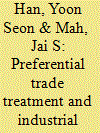

|
|
|
|
|
| Summary/Abstract |
The garment industry is important for Cambodia’s economy not only because it generates noticeable export earnings and employment, but also because it contributes significantly to the economic growth of the country. Due to the bilateral trade agreements that exist between Cambodia and the USA, the majority of Cambodia’s garment exports are destined for the US market. The European Union (EU) has also given preferential treatment to Cambodia’s export of garments and this is expected to lead to an increase in the volume of Cambodia’s export of garments to the EU. Thus, the case of Cambodia indicates that preferential treatment by developed countries may contribute significantly to the export expansion and economic growth of a developing country. In terms of foreign direct investment (FDI) inflows, China has played a leading role. China’s investment in Cambodia’s garment industry has enabled a strengthening of production capacity.
|
|
|
|
|
|
|
|
|
|
|
|
|
|
|
|
| 9 |
ID:
091732


|
|
|
|
|
| Publication |
2009.
|
| Summary/Abstract |
Based on a case study of an export-oriented Bangladeshi garment company, this article shows how hierarchies of vulnerability have developed in the process of global integration of Bangladesh's garment industry. Situating the problem of economic dependency in a globalised context within a broader political economy discussion of local Bangladeshi scenarios, the study illustrates how such patterns of development are shaped by internal as well as external social and political forces that create conditions of vulnerability.
|
|
|
|
|
|
|
|
|
|
|
|
|
|
|
|
| 10 |
ID:
141399


|
|
|
|
|
| Summary/Abstract |
Shanghai’s modern fashion industry developed between the last decades of the nineteenth century and the 1930s and was an important step in China’s industrialisation. The present article aims to define the relationship between production and consumption in Shanghai’s modern fashion industry. One of the main characteristics of modern fashion is its ability to innovate by creating new and distinct trends while absorbing different influences. Shanghai modern fashion was an original mix of Chinese and foreign styles. The second determinant of this phenomenon is its capacity to be distinctive and reproducible at the same time. Shanghai’s modern fashion therefore only emerged when the city was able to innovate and produce goods on a massive scale that were adapted to consumer tastes. To prove this relationship, the present article establishes concrete links between traders, industrialists, and retailers. The textile industry benefited from the outcome of a complex network that linked foreign trade, cotton mills, retail shops, and mass publicity. This paper analyses how this economic network was developed.
|
|
|
|
|
|
|
|
|
|
|
|
|
|
|
|
|
|
|
|
|